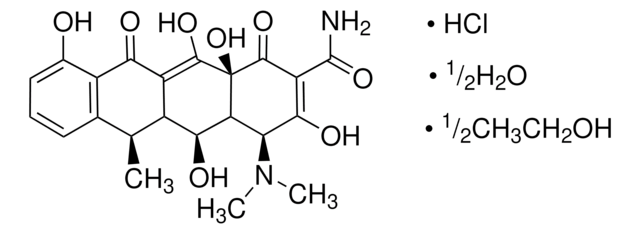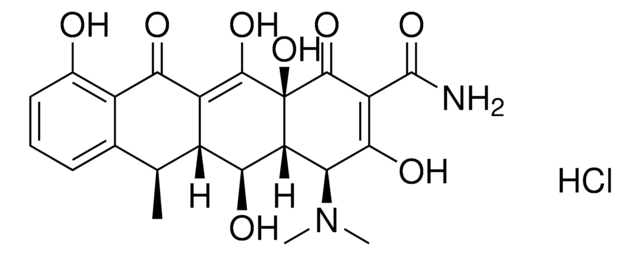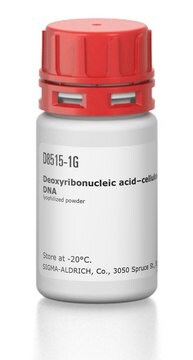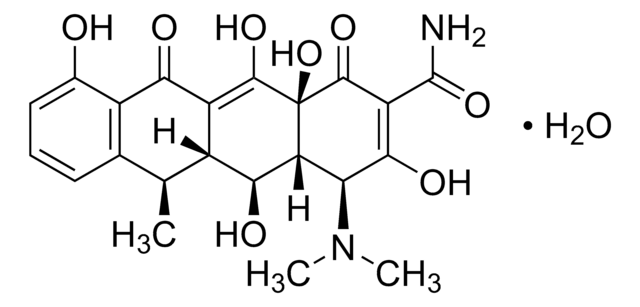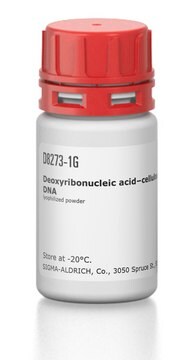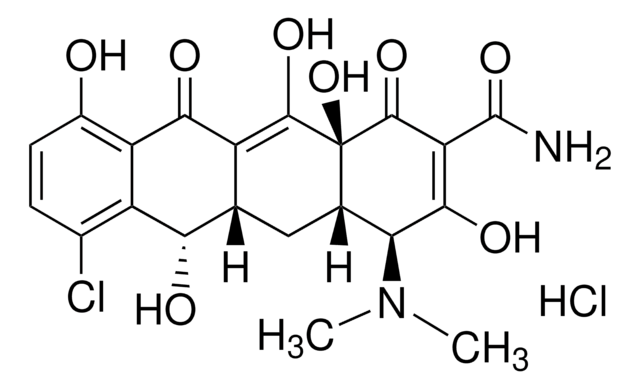D9891
Doxycycline hyclate
Synonyme(s) :
Chlorhydrate de doxycycline hémiéthanolate hémihydrate
About This Item
Produits recommandés
Source biologique
synthetic
Niveau de qualité
Essai
≥93.5% (HPLC)
95.0-102.0% anhydrous basis (ethanol free based)
Forme
powder
Conditions de stockage
(Tightly closed. Dry. )
Couleur
yellow to yellow-green
Spectre d'activité de l'antibiotique
Gram-negative bacteria
Gram-positive bacteria
mycoplasma
parasites
Mode d’action
protein synthesis | interferes
Température de stockage
2-8°C
Chaîne SMILES
Cl[H].Cl[H].[H]O[H].CCO.C[C@@H]1C2[C@H](O)C3[C@H](N(C)C)C(O)=C(C(N)=O)C(=O)[C@@]3(O)C(O)=C2C(=O)c4c(O)cccc14.C[C@@H]5C6[C@H](O)C7[C@H](N(C)C)C(O)=C(C(N)=O)C(=O)[C@@]7(O)C(O)=C6C(=O)c8c(O)cccc58
InChI
1S/2C22H24N2O8.C2H6O.2ClH.H2O/c2*1-7-8-5-4-6-9(25)11(8)16(26)12-10(7)17(27)14-15(24(2)3)18(28)13(21(23)31)20(30)22(14,32)19(12)29;1-2-3;;;/h2*4-7,10,14-15,17,25,27-29,32H,1-3H3,(H2,23,31);3H,2H2,1H3;2*1H;1H2/t2*7-,10?,14?,15-,17-,22-;;;;/m00..../s1
Clé InChI
HALQELOKLVRWRI-ZVACAFRPSA-N
Vous recherchez des produits similaires ? Visite Guide de comparaison des produits
Description générale
Outre ses effets antimicrobiens, l'hyclate de doxycycline inhibe les métalloprotéinases matricielles (MMP), des enzymes cruciales pour la dégradation du collagène dans les tissus conjonctifs. Des études portant sur l'érosion de la cornée et la polyarthrite rhumatoïde montrent respectivement une réduction significative des taux de MMP-9 et MMP-8. Cette faculté à inhiber les MMP contribue à préserver l'intégrité du collagène, en prévenant une dégradation excessive des tissus et en facilitant leur réparation.
En biologie cellulaire, l'hyclate de doxycycline influe sur les cellules des muscles lisses, en renforçant l'adhérence et en modifiant la réorganisation des matrices de collagène fibrillaire. Son influence sur l'expression génique des apicoplastes chez Plasmodium falciparum, le parasite à l'origine du paludisme, renforce l'intérêt des recherches sur les maladies infectieuses. En outre, l'inhibition de la formation des tissus observée dans des études sur le rat renforce son importance pour la compréhension du développement tissulaire.
Par ailleurs, l'hyclate de doxycycline pourrait présenter un certain intérêt pour la recherche en métabolomique, compte tenu de ses effets aux multiples facettes sur divers processus cellulaires. Dans le cadre plus large de la recherche en biochimie, ses nombreux effets en font un outil intéressant pour étudier les mécanismes moléculaires et les voies de signalisation.
Application
Actions biochimiques/physiologiques
Spectre d'activité : Inhibiteur à large spectre des métalloprotéinases matricielles in vivo.
Caractéristiques et avantages
- Antibiotique de grande qualité convenant à de nombreuses applications de recherche.
- Idéal pour la recherche en biologie cellulaire, en métabolomique et en biochimie.
Autres remarques
Souvent commandé avec ce produit
Mention d'avertissement
Warning
Mentions de danger
Conseils de prudence
Classification des risques
Acute Tox. 4 Oral - Aquatic Chronic 3 - Eye Irrit. 2 - Repr. 2 - Skin Irrit. 2 - STOT SE 3
Organes cibles
Respiratory system
Code de la classe de stockage
11 - Combustible Solids
Classe de danger pour l'eau (WGK)
WGK 3
Point d'éclair (°F)
Not applicable
Point d'éclair (°C)
Not applicable
Équipement de protection individuelle
dust mask type N95 (US), Eyeshields, Gloves
Faites votre choix parmi les versions les plus récentes :
Déjà en possession de ce produit ?
Retrouvez la documentation relative aux produits que vous avez récemment achetés dans la Bibliothèque de documents.
Les clients ont également consulté
Notre équipe de scientifiques dispose d'une expérience dans tous les secteurs de la recherche, notamment en sciences de la vie, science des matériaux, synthèse chimique, chromatographie, analyse et dans de nombreux autres domaines..
Contacter notre Service technique